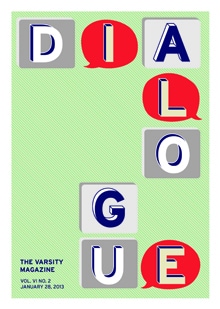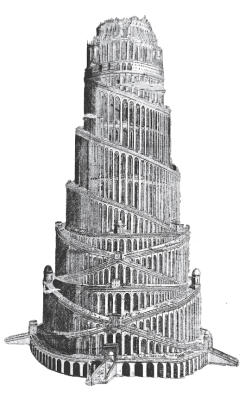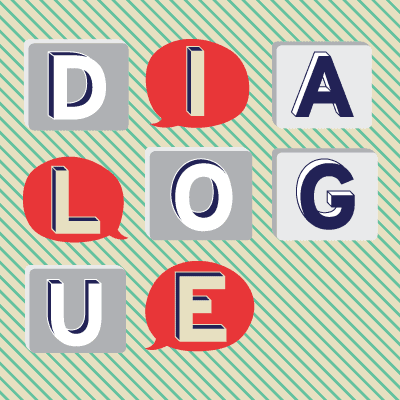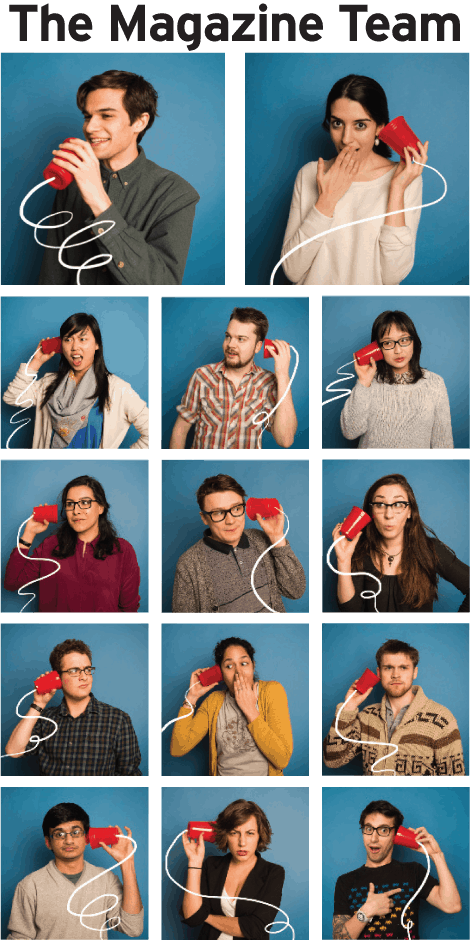Table of Contents
Letter from the Editor
Letter from the Design Team
The Magazine Team
Speech bubbles
A place to talk
Digital dialogue
Food for thought
Recording a scene
Salon culture
Intellectual theft, disco, and Bollywood
Creepin’ Conversations
Bar speak
Conducting Conversations
Follow my lead
Behind the scenes, beneath the pages
The Universal Language?
Native tradition, new theatre
Stepping on stage
Cross-cultural Christmas
Learning to read the signs
Reading between the pixels
Letter from the Editor
We’re talking, but are we listening?
 Probably not. The truth is it’s sometimes easier to just tune everything out and look ahead. If you’ve got to get something done, it can be simplest to keep your head down, not listen to outside voices, and try to get the work done. Trying to figure out our lives as university students, we often barely have time for others or just assume that we know what’s best for ourselves. Right now, it seems like the aspiration of most young writers is to craft the perfect personal essay: a piece that will reveal how exciting and interesting their life is. A piece that involves no interviews or real outside research, but instead draws on the rich tapestry of the writer’s past, perhaps with a phone call or email to an old friend thrown in to confirm a stray detail. To be honest, when I read an article or loosely fictionalized story along these lines, I just get frustrated that I couldn’t come up with a viable idea for a piece of my own.
Probably not. The truth is it’s sometimes easier to just tune everything out and look ahead. If you’ve got to get something done, it can be simplest to keep your head down, not listen to outside voices, and try to get the work done. Trying to figure out our lives as university students, we often barely have time for others or just assume that we know what’s best for ourselves. Right now, it seems like the aspiration of most young writers is to craft the perfect personal essay: a piece that will reveal how exciting and interesting their life is. A piece that involves no interviews or real outside research, but instead draws on the rich tapestry of the writer’s past, perhaps with a phone call or email to an old friend thrown in to confirm a stray detail. To be honest, when I read an article or loosely fictionalized story along these lines, I just get frustrated that I couldn’t come up with a viable idea for a piece of my own.
Of course, personal stories with strong narratives have their place, as they should. But to be able to continue to write, and not just recount some weird night two summers ago, you need to put yourself out there, interview and listen to people, and attempt to understand any contradictions that you encounter. In other words, you need to participate in a dialogue.
In choosing dialogue as the theme of our arts magazine, we wanted to take a chance to look out at the world. Yes, inward refection is an essential part of processing life, but our overall interactions with art and other people are built up from the small conversations and exchanges that happen everyday. Our writers turned their attention to the role dialogue plays in creativity (Murad Hemmadi’s article on the conversations that feed the process of ghostwriting), and how it shapes our connection with art (Damanjit Lamba’s piece on online communication between artists and their audiences). They even raised the question of whether conversation itself can be considered an art (a bartender and a hairstylist give their perspectives here and here).
The magazine is also about how dialogue is changing. You’ll note that while the musicians and photographer that Lamba interviewed are better connected to their fans than they would have been just a few years ago, there are no bands or collectives present in the article. Immersed in fast-paced digital media, is a face-to-face dialogue simply impossible? Sophia Costomiris reflects on the difference between digital and print dialogue, highlighting thought-provoking, and frankly scary, points about how the way we communicate is evolving. This magazine may not contain clear answers to these doubts about the future, but that’s not the point. Instead, our aim is to get you asking questions and starting discussions, maybe even arguments. Enjoy the magazine!
Simon Frank,
Varsity Magazine Editor, 2012-2013
Visualizing Dialogue
 Babel isn’t such a bad idea. Strip the story down to its bones (there isn’t much to strip anyway, it’s only nine biblical verses long), and it’s about people with the capacity to communicate enough to build something big.
Babel isn’t such a bad idea. Strip the story down to its bones (there isn’t much to strip anyway, it’s only nine biblical verses long), and it’s about people with the capacity to communicate enough to build something big.
In our last magazine issue, we strove to present the different experiences of the night. The time between sundown and sunrise contains infinite stories, and displaying them demanded emphatic difference.
This time we’ve taken another tack. Dialogue requires diversity, but it also demands enough in common to talk to one another. The stories in this magazine approach dialogue in drastically different ways, but at their core they’re all about communicating with each other. We’ve tried to reflect this in the shape the magazine has taken, paring down visually in order to let them speak for themselves, to each other, and to the reader.
Get conversating.
The Design Team



